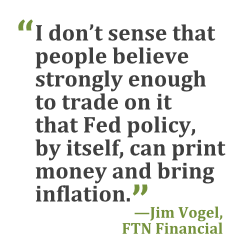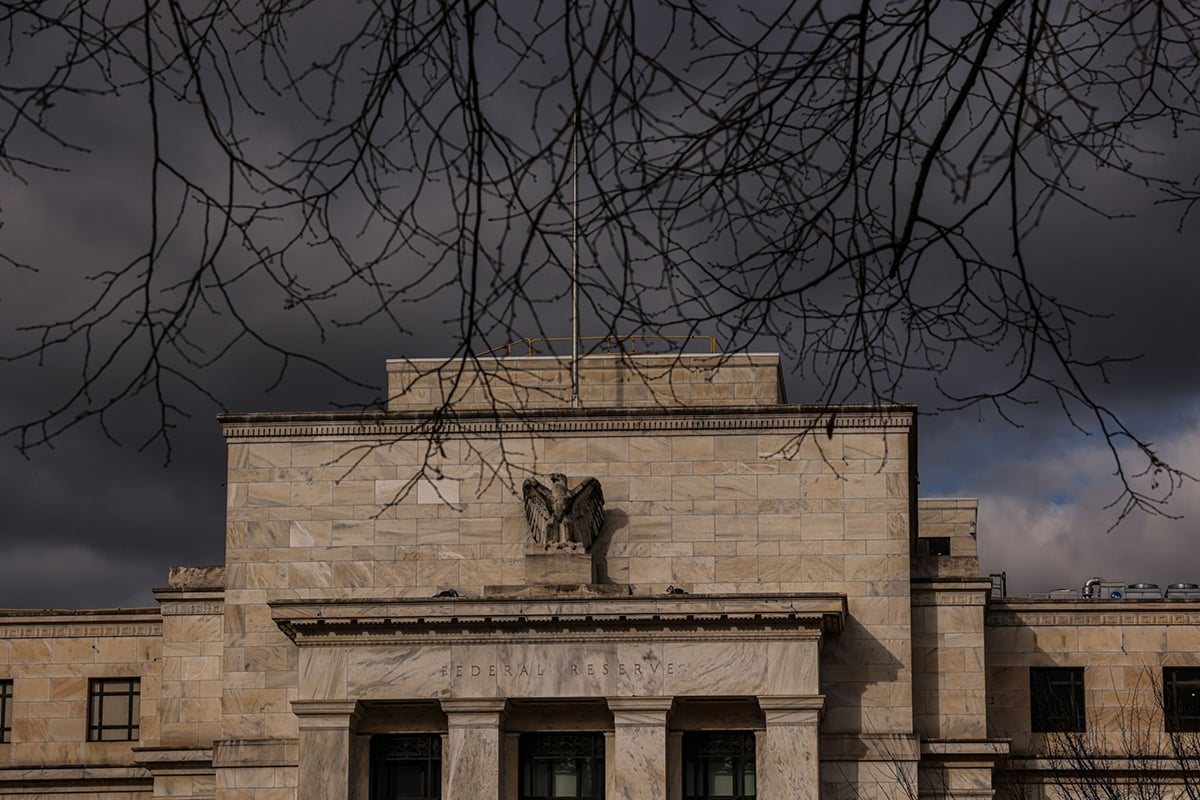As the Federal Reserve winds down its third round ofunprecedented stimulus, one thing has become increasingly clear inthe bond market: The U.S. economy just isn't going to grow enoughto upend demand for Treasuries.
|While more than $3 trillion of debt purchases since 2008 havehelped the U.S. recover from its worst recession in seven decades,bond-market indicators for long-term inflation, growth, and fundingcosts are all lower now than they were at the end of the centralbank's first two rounds of quantitative easing.
| Investors' diminished outlook for the economy could helpprevent an exodus from the $12.2 trillion market for Treasuries andcontain long-term borrowing costs for the government, companies,and consumers as the Fed moves toward raising interest rates. Afterdemand for the benchmark 10-year note this year pushed down yieldsby almost half a percentage point, to 2.61 percent, implied yieldsnow suggest investors don't foresee them increasing to 3 percentfor at least another year.
Investors' diminished outlook for the economy could helpprevent an exodus from the $12.2 trillion market for Treasuries andcontain long-term borrowing costs for the government, companies,and consumers as the Fed moves toward raising interest rates. Afterdemand for the benchmark 10-year note this year pushed down yieldsby almost half a percentage point, to 2.61 percent, implied yieldsnow suggest investors don't foresee them increasing to 3 percentfor at least another year.
“Investors putting money to work are much more pessimistic, notjust about the state of the U.S. economy but how well it cansustain a rate hike,” Aaron Kohli, a New York-based interest-ratestrategist at BNP Paribas SA, said in a telephone interview onSept. 11. “What the Fed may see as we get closer to a rate hike isthe economic strength they thought was there is more of amirage.”
|Kohli, whose firm is one of the 22 primary dealers that tradedirectly with the Fed, recommends buying 30-year U.S. bonds andselling those due in two years to three years.
|'Considerable Time'
|The debate over the Fed's interest-rate policy and its effect onbonds has intensified with the bank poised to end its third roundof debt purchases, known as QE3, next month.
|The central bank, which reduced its monthly purchases to $25billion in August from $35 billion in July, has bought so manybonds that its assets have ballooned to $4.42 trillion from lessthan $1 trillion in 2008.
|Fed policy makers, who gather for a two-day meeting tomorrow,are already reassessing their own views on how long the target rateneeds to stay close to zero as the U.S. recovery enters its sixthyear. They are now considering whether to alter the guidancethey've had since March saying the rate would stay low for a“considerable time” after the Fed stops buying bonds.
|Philadelphia Fed President Charles Plosser, who dissented at theFed's last meeting in July, said Sept. 6 that keeping rates so lowis a “risky strategy.”
|Speculation the Fed's policy statement this week will indicateofficials are closer to lifting rates pushed up yields on the10-year note by 0.15 percentage point last week, the biggest jumpsince August 2013.
|Getting it right has never been more important for the Fed. Withtrillions of dollars of debt such as home loans and corporate bondstied to Treasuries, any jump in borrowing costs threatens to stiflean economy that's failed to generate more than 3 percent growth inany year since the recession ended.
|Even after six years of monetary stimulus, the bond market issignaling that the economy's potential to produce the kind ofgrowth that compels Fed Chair Janet Yellen to aggressively liftrates and curb demand for fixed-income assets has lessened.
|Bond traders now see consumer prices increasing an average 2.34percent annually over the five years starting 2019, based on thefive-year, five-year forward break-even rate, a metric the Fed usesto gauge long-term inflation expectations.
||The level is within 0.01 percentage point of a three-year lowand is also lower than at the end of both QE2 in June 2011 and theFed's first QE in March 2010, when inflation expectations in thebond market were above 3 percent.
|Actual inflation using the Fed's preferred measure has remainedbelow its 2 percent target for 27 consecutive months.
|“I don't sense that people believe strongly enough to trade onit that Fed policy, by itself, can print money and bringinflation,” Jim Vogel, the Memphis, Tennessee-based interest-ratestrategist at FTN Financial, said on Sept. 8.
|One of the biggest reasons bond investors are skeptical thatconsumer price increases will accelerate is because sustained wagegrowth among U.S. workers remains elusive.
|On an annual basis, growth in hourly earnings in the past fiveyears has been the weakest over the course of any expansion sinceat least the 1960s, data compiled by Bloomberg show. Employersadded just 142,000 jobs last month, the fewest this year, halting asix-month streak of employment gains surpassing 200,000 that wasthe most since 1997.
|Growth Prospects
|The lack of earnings growth may hamper consumer spending, whichaccounts for 70 percent of the economy, and also constrain futuregrowth. The narrowing gap between short- and long-term yieldssuggests the bond market supports that view.
|The difference between five- and 30-year Treasuries, whichusually widens as growth prospects improve, was at 1.54 percentagepoints as of 11:58 a.m. in New York. That's at least 0.4 percentagepoint less than at the end the two prior rounds of QE. Since thestart of QE3, the gap has fallen 0.85 percentage point.
|Donald Ellenberger, who oversees about $10 billion as the headof multi-sector strategies at Federated Investors, says bondinvestors are missing the signs that support forecasts for thefastest U.S. economic growth in a decade next year.
|Sales at retailers climbed 0.6 percent in August, the quickestpace in four months, while manufacturing rose to a more thanthree-year high. At the same time, banks boosted the amount ofbusiness loans to a record $1.75 trillion last month.
|The rally in the Standard & Poor's 500 Index of Americanequities to an all-time high is also a sign the U.S. economy isstrengthening, according to Ellenberger.
|Judging the economy “depends on what indicators you're lookingat,” Ellenberger, who holds a smaller proportion of Treasuries thanallocated in benchmarks, said by telephone from Pittsburgh. “Thefundamentals to support it are improving.”
|Options traders are also stepping up wagers that stronger growthwill lead the Fed to raise interest rates more than they previouslypriced in.
|Bearish options that expire in coming months on Eurodollarfutures due in December 2017 now exceed bullish contracts by3-to-1, double the ratio eight weeks ago, data compiled by CMEGroup Inc. show. That implies traders are more confident than theywere in the past that rates will rise to higher levels.
|Even after 10-year Treasuries suffered their longest losingstreak of the year, traders are confident that yields will remainbelow levels demanded in previous periods of growth.
|Lost Potential
|Implied yields on 10-year Treasuries suggest that they won'treach 3 percent until October next year. That's at least 0.7percentage point less than at the end of the two prior QE cycles.Ten-year yields averaged more than 4 percent over the course of thelast two expansions.
|Treasuries have rallied this year, confounding forecasters whopredicted yields would rise as the economy strengthened.
|While the prognosticators have pointed to everything from theharsh winter to turmoil in Russia and the Middle East for whyTreasuries remain in demand, lower potential growth of the U.S.economy may be a better reason, according John Bellows, thePasadena, California-based money manager at Western AssetManagement, which oversees $75 billion of fixed income.
|“You never quite get back” the growth you've lost from thecredit crisis, he said in a Sept. 11 interview at Bloombergheadquarters in New York. “You do lose some potential.”
|Copyright 2018 Bloomberg. All rightsreserved. This material may not be published, broadcast, rewritten,or redistributed.
Complete your profile to continue reading and get FREE access to Treasury & Risk, part of your ALM digital membership.
Your access to unlimited Treasury & Risk content isn’t changing.
Once you are an ALM digital member, you’ll receive:
- Critical Treasury & Risk information including in-depth analysis of treasury and finance best practices, case studies with corporate innovators, informative newsletters, educational webcasts and videos, and resources from industry leaders.
- Exclusive discounts on ALM and Treasury & Risk events.
- Access to other award-winning ALM websites including PropertyCasualty360.com and Law.com.
*May exclude premium content
Already have an account? Sign In
© 2024 ALM Global, LLC, All Rights Reserved. Request academic re-use from www.copyright.com. All other uses, submit a request to [email protected]. For more information visit Asset & Logo Licensing.







